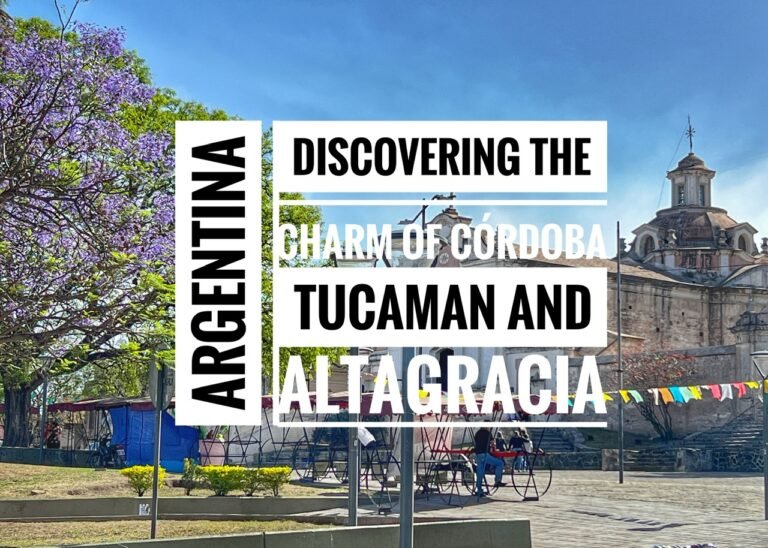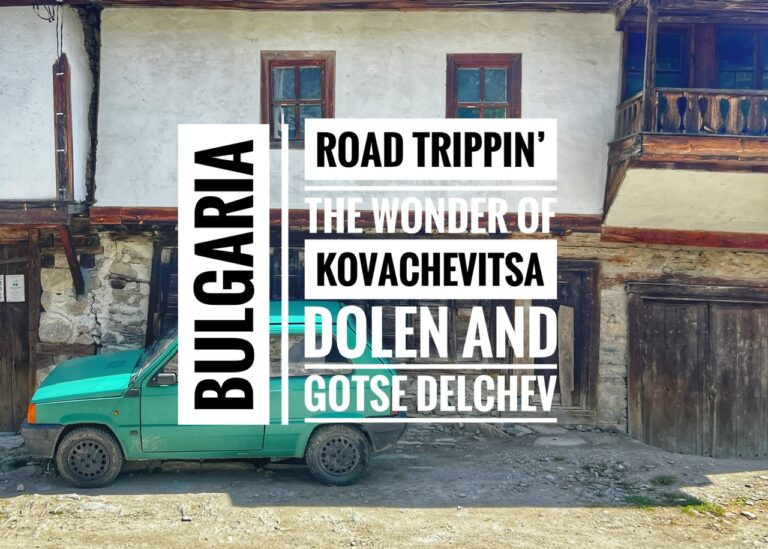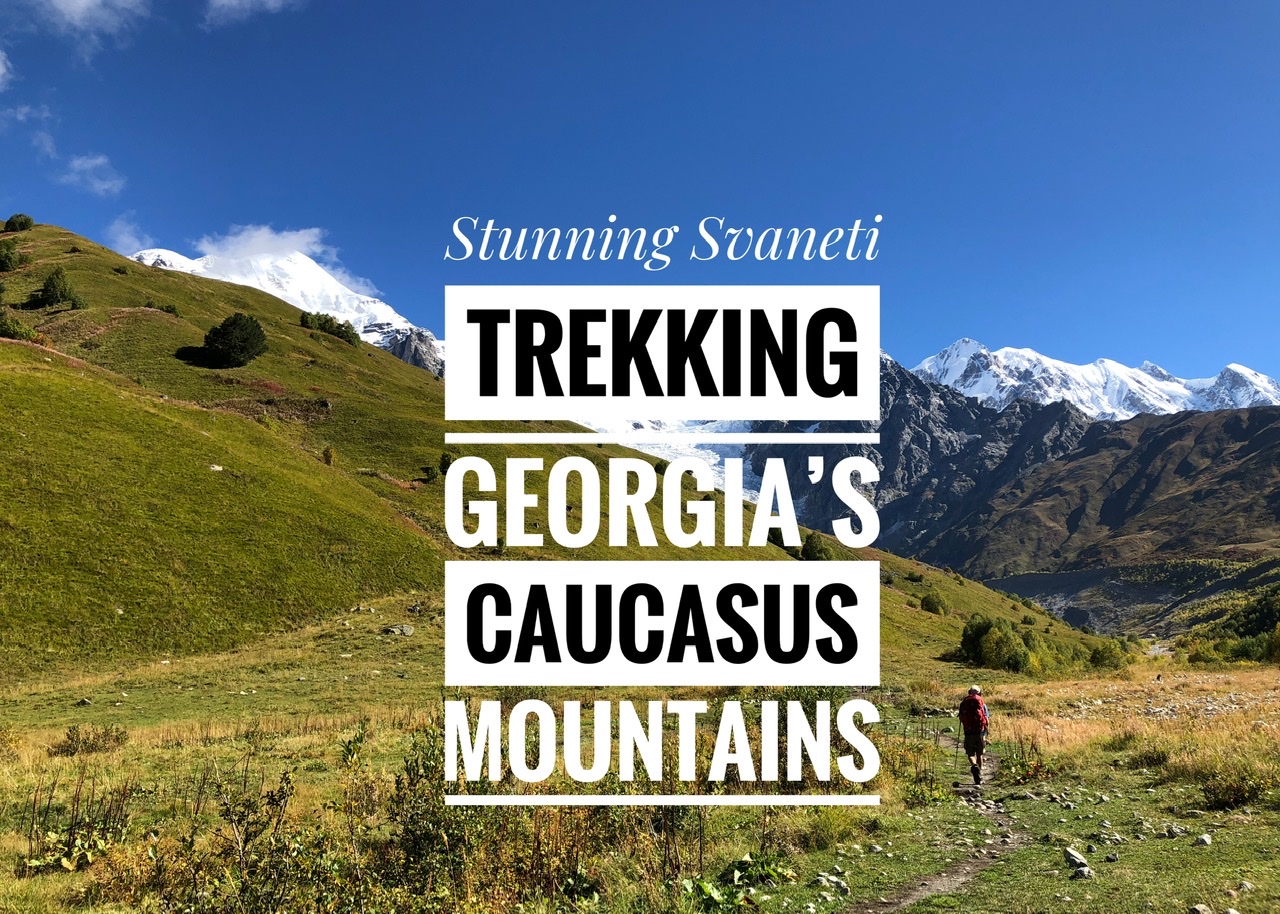
Attention all walkers and hikers, it’s time to book a flight…now…to Georgia. (And we don’t mean the state-of-peaches!) The Republic of Georgia will undoubtedly be a tourist hot spot within 10 years, so don’t delay if you want to beat the crowds! We headed here because our entire travel itinerary, in fact, has been planned around doing long distance treks like the one we just did in Georgia. The closer we looked at Georgia, the more dynamic it became, and we knew our first trekking experience was destined to be in Svaneti in Northwest Georgia. Svaneti is a historical region blessed with dramatic snow capped peaks, rivers and streams in deep gorges, high pastures full of sheep, goats, and cows, and (intact) medieval villages where time seems to have slowed down enough to make you feel like you are in a living museum, all of this region directly borders Russia to the north. All ripe for exploration and getting to the roots of why we travel.
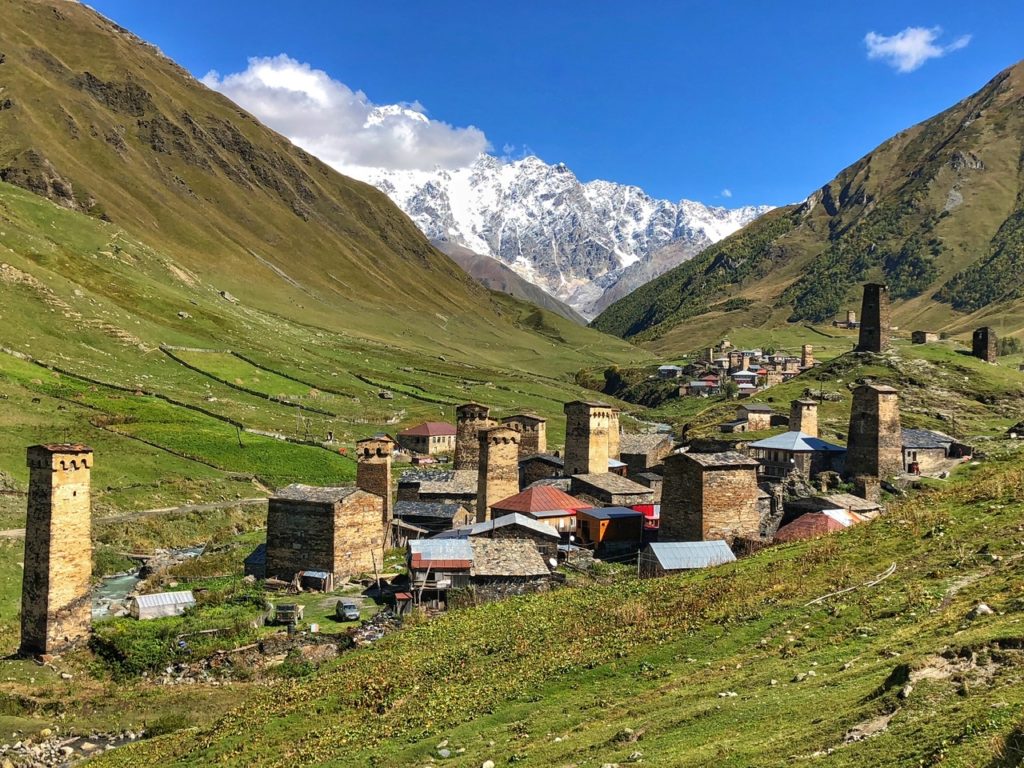
At an elevation of 6,844 feet, the village of Ushguli is the highest continuously inhabited place in Europe. It also served as the grand finale on our four day hiking trek.

Our adventure started with a six-hour ride from Batumi to Mestia in a marshrutka, which is essentially Georgia’s public transportation, an outdated passenger van that shuttles people around the country with limited schedule information, and is perfect for the budget-minded traveler ($15/person). Take your Dramamine if you’re sensitive to being carsick because this ride is not only long, but also comparable to an obnoxious carnival ride that lasts for hours as you snake your way up the pot-hole-infested mountain roads and around hair-pinned corners with thousand foot drop-offs. We were a little nervous that our backpacks might go flying off the side, but fortunately they were tied down to the top, and also wedged protectively next to the very practical giant pink suitcase of our mashrutka fellow traveler.
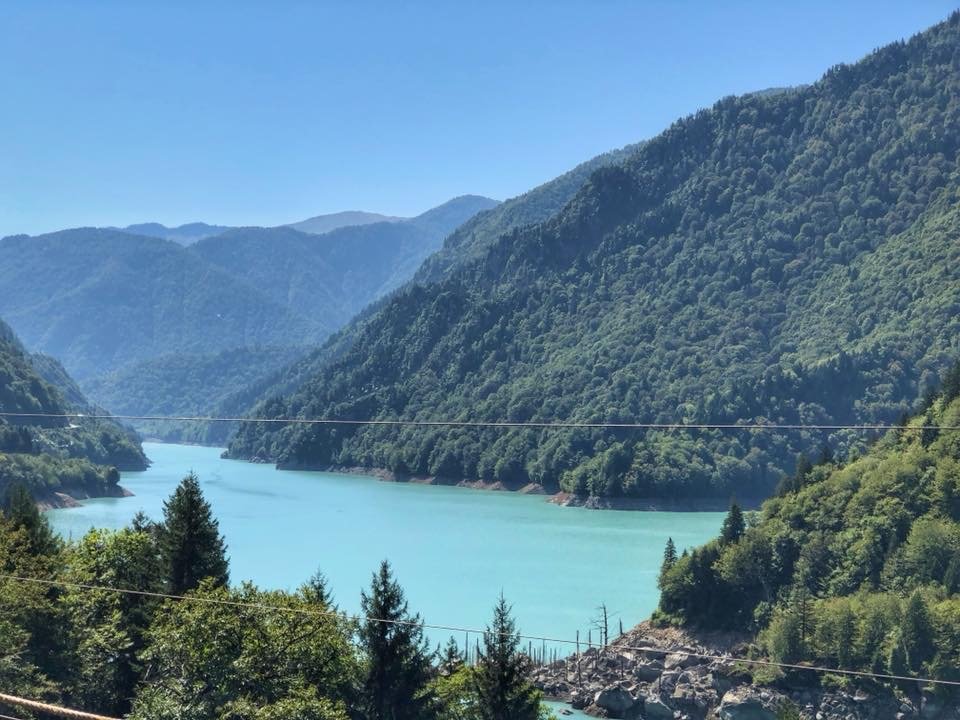
A stop at the grand dam Enguri, one of the largest dams in the world- 271.5 meters high and 728 meters long-which dams the Enguri River into this beautiful reservoir which is framed with wooded mountains. Milky white from Glacial “flour” in the water, We thought it looked a lot like some of the lakes we’d seen in the Canadian Rockies.
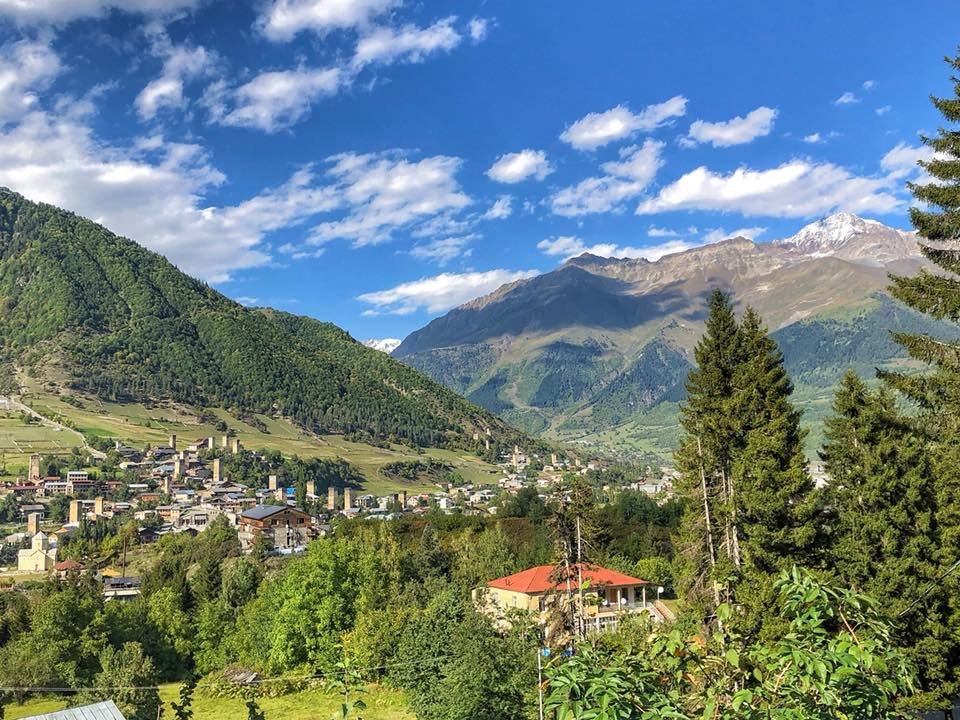
A stop at the grand dam Enguri, one of the largest dams in the world- 271.5 meters high and 728 meters long-which dams the Enguri River into this beautiful reservoir which is framed with wooded mountains. Milky white from Glacial “flour” in the water, We thought it looked a lot like some of the lakes we’d seen in the Canadian Rockies.
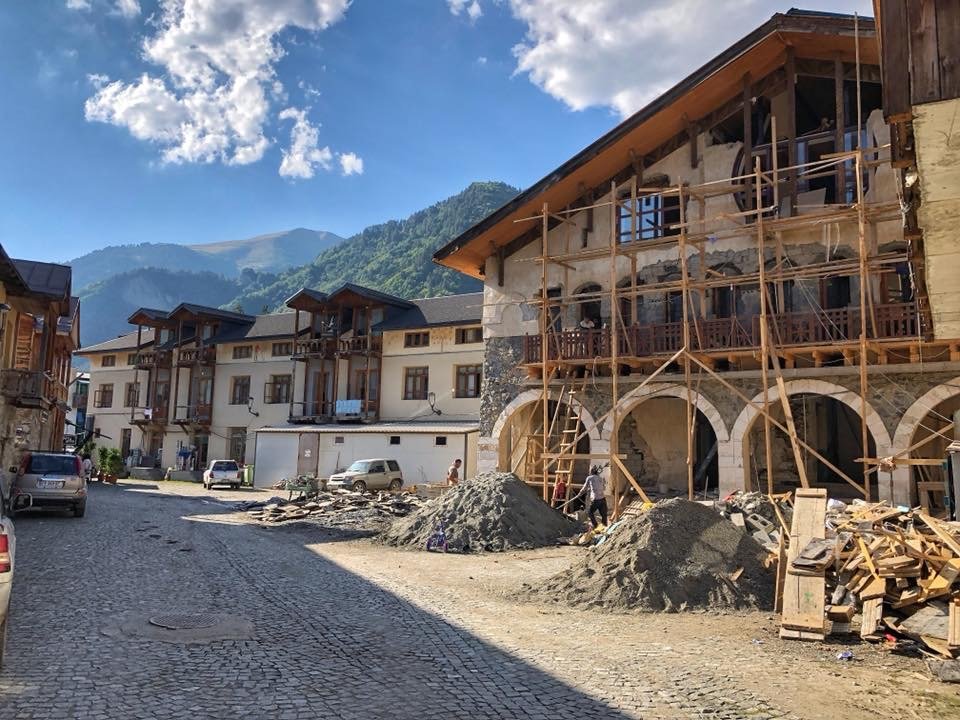
It is evident that this town is on the verge of a significant tourism boom. Construction is abundant as houses are remodeled into guesthouses and restaurants are popping up so fast that the majority don’t even have an online presence, and the ones that do have no or few reviews yet.

Despite the endless construction, the cows that aimlessly roam the streets reminded us we’re still far from the city life we had been growing exhausted from. Waking up to cock-a-doodle-doos and moos was exactly what we needed. Plus it was mildly entertaining to watch them get in “traffic” jams. 🙂
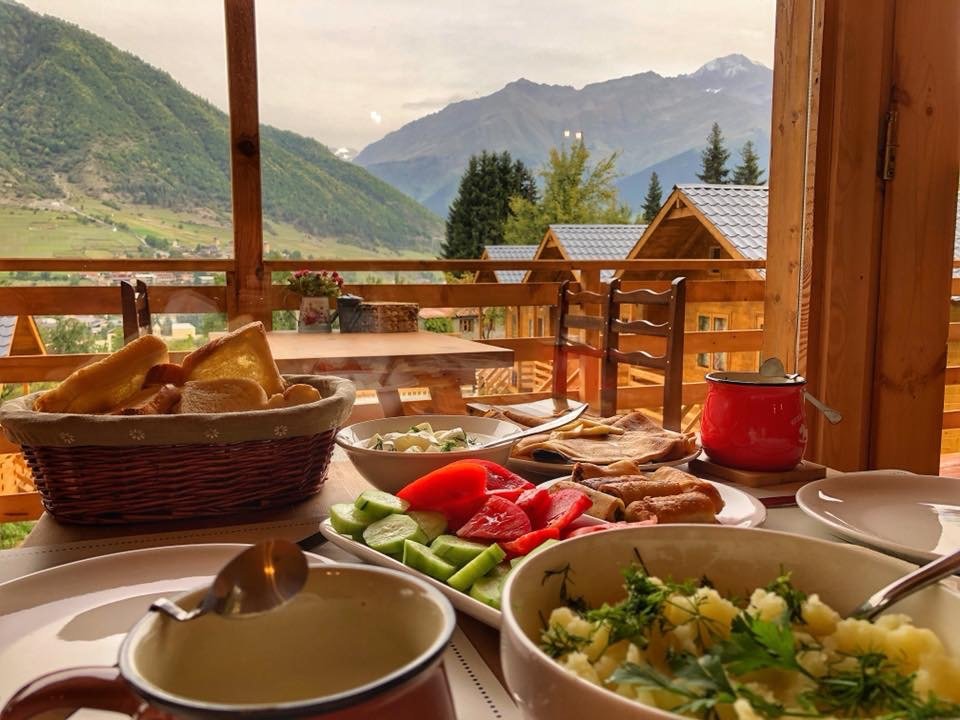
The view and the breakfast from our cottage window, where we stayed for three nights. The breakfast spread was 10 Georgian Lari ($4) and included a giant spread of the best banana/peach pancakes, dill cheesy mashed potatoes, Georgian salad, cheese bread, and more. Absolutely delicious home cooking! Everything here is locally sourced, being in these mountains if you can’t grow it or make it you don’t eat it. It’s simply an amazing cuisine!
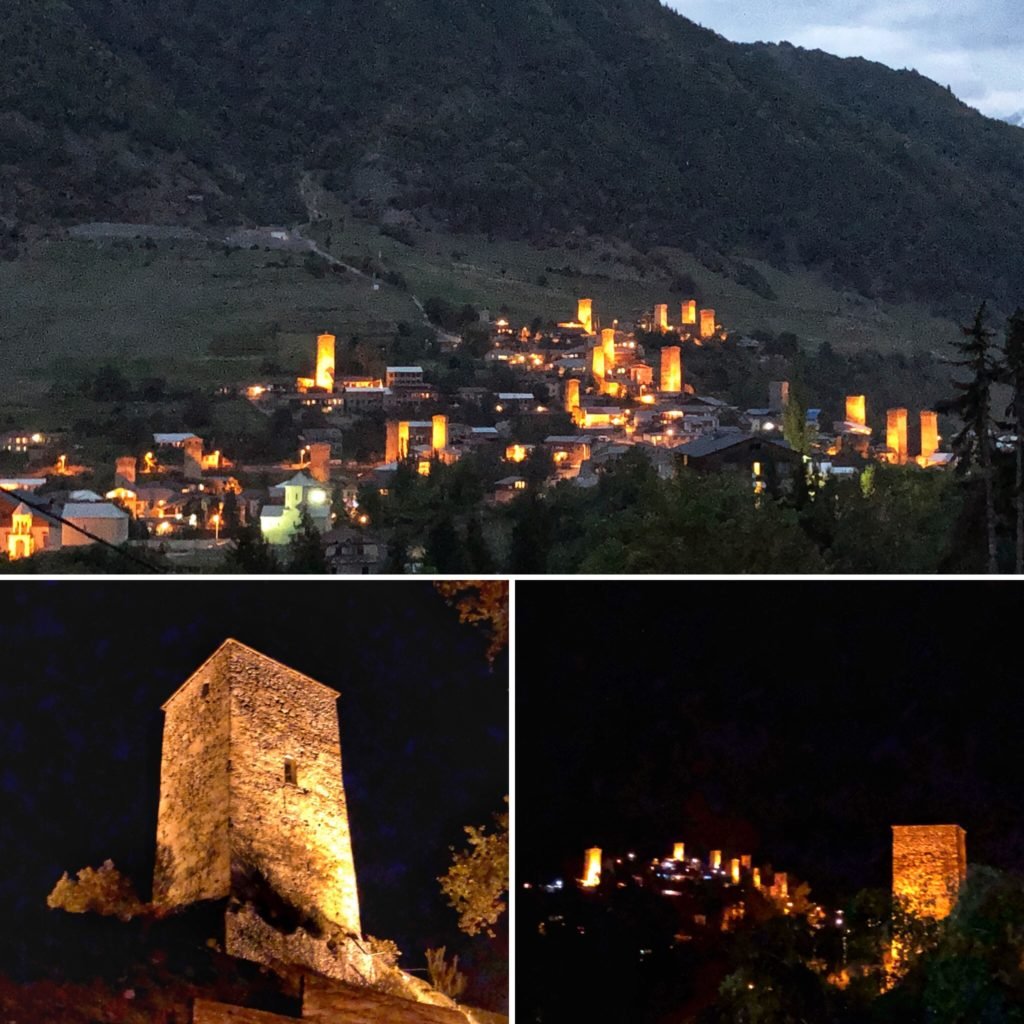
The view of the towers at night was awesome, and enchanting. We have never seen anyplace like this… medieval!

Where we stayed!
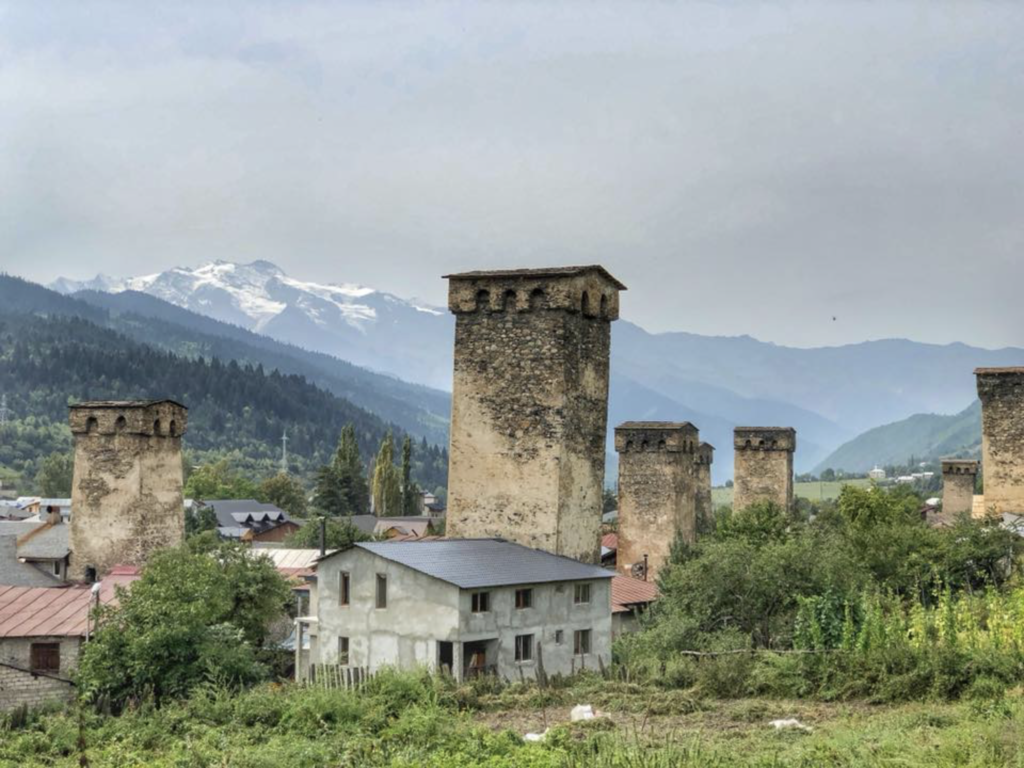
The magnificent medieval Svetian stone tower-houses (Koshkebi) which dot the townscape like giant exclamation marks. It is simply astonishing how many of the structures have remained intact. Around 175 koshkebi, most originally built between the 9th and 13th centuries, survive in the Svaneti region. Wandering among them and the Svaneti villages felt like being inside a living museum.
Usually between three and five stories high with stone walls that decrease in thickness as they rise, the towers have a slender, tapering profile, and are capped with a square roofed top with two or three windows on each side. These tower-houses likely functioned as dwellings, storehouses, and defense posts to guard against invaders. Presumably the windows at the top would be occupied by archers able to strategically shoot any would be invaders below from relative safety. The Svaneti tower-houses are numerous in the region due to the clanlike social structure (surviving here into the 19th or even 20th century) that existed in a country where fierce competition over limited natural resources led to chronic feuding between neighbours. One theory suggests that private tower-like structures proliferate in areas where central authority is weak, leading to a need for a status symbol incorporating private defences against small-scale attacks (Wikipedia.)

One of the more modern churches, in Byzantine-style, dominating Mestia.
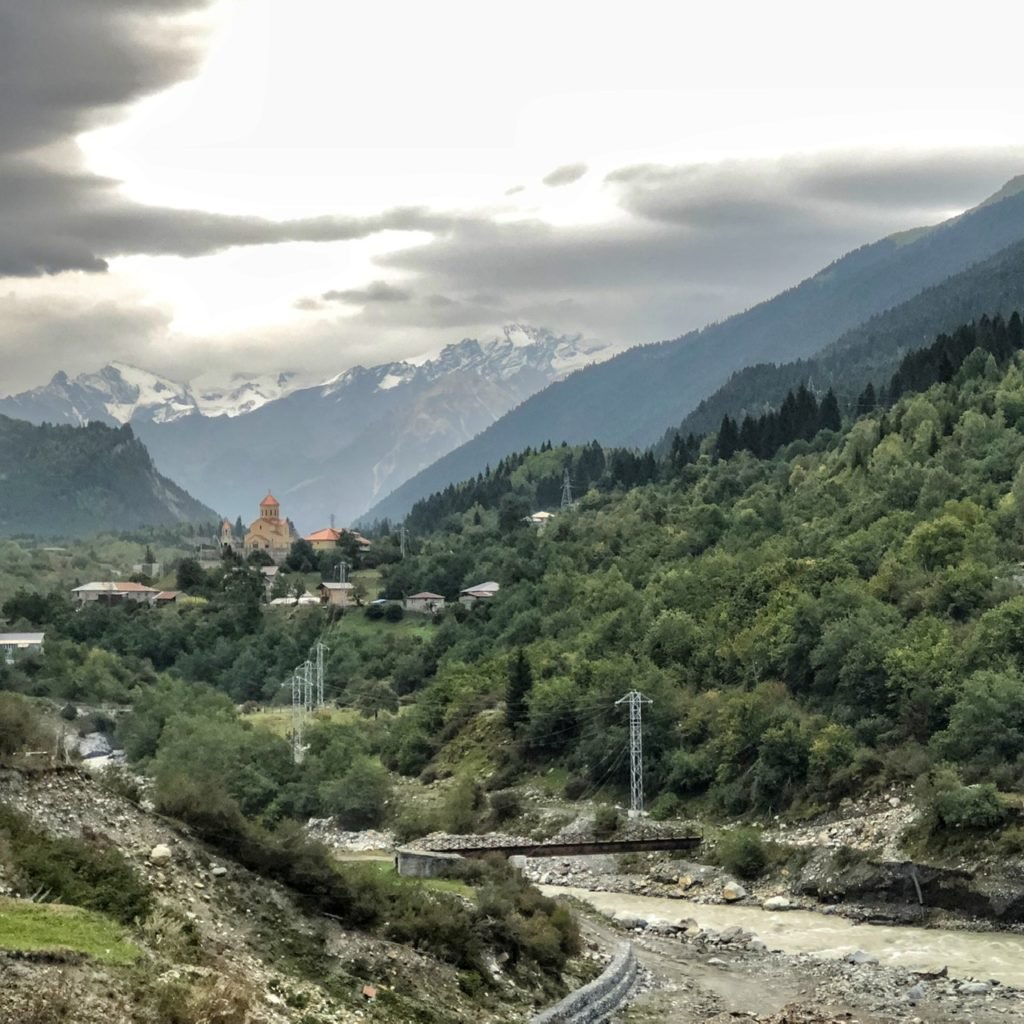
A view of the Caucuses in Mestia.
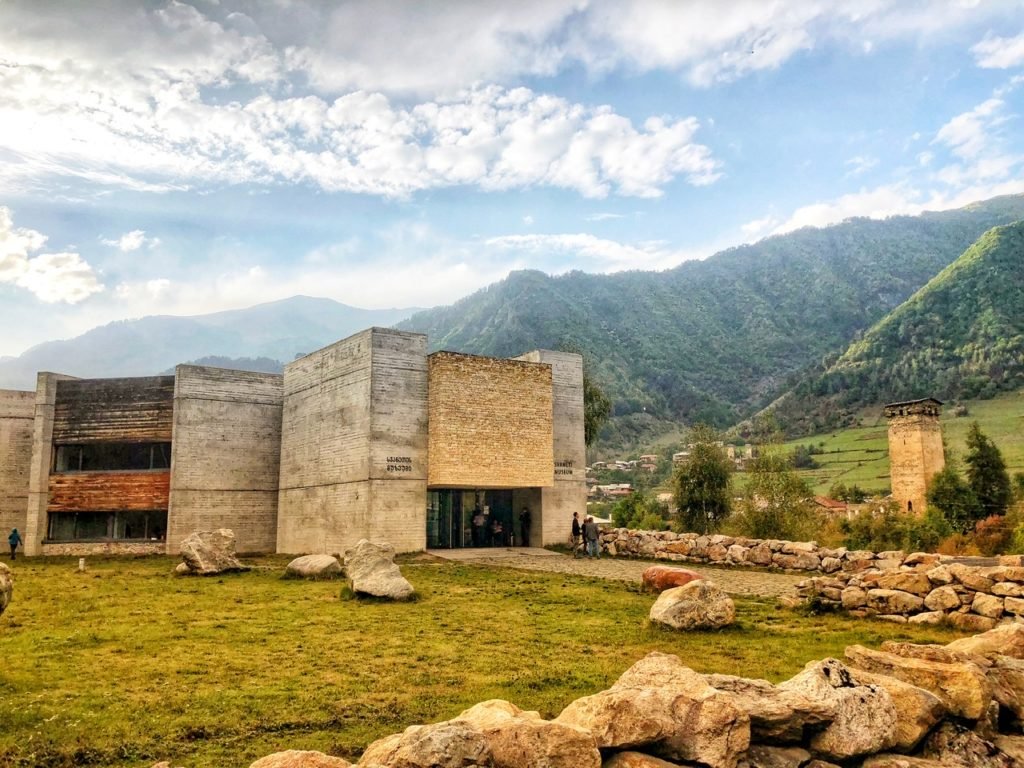
The town of Mestia has a great ethnographic museum, that is definitely worth a wander. Inside there are Georgian treasures almost exclusively from the 10th and 9th centuries (!) that include an amazing range items from Georgian church treasuries (the Upper Svaneti region was used as a safe-house by the church to store their treasures and precious iconography due to its rugged mountain inaccessibility and low risk for looting by conquering armies), books and religious manuscripts (the oldest from 897 AD), medieval weaponry, coins (dating from 6th century BC(!!) up to the 1930’s.), and traditional Svan musical instruments and clothing. Everything was wonderfully labelled in English and Georgian, and beautifully displayed into an amazing collection of artifacts.
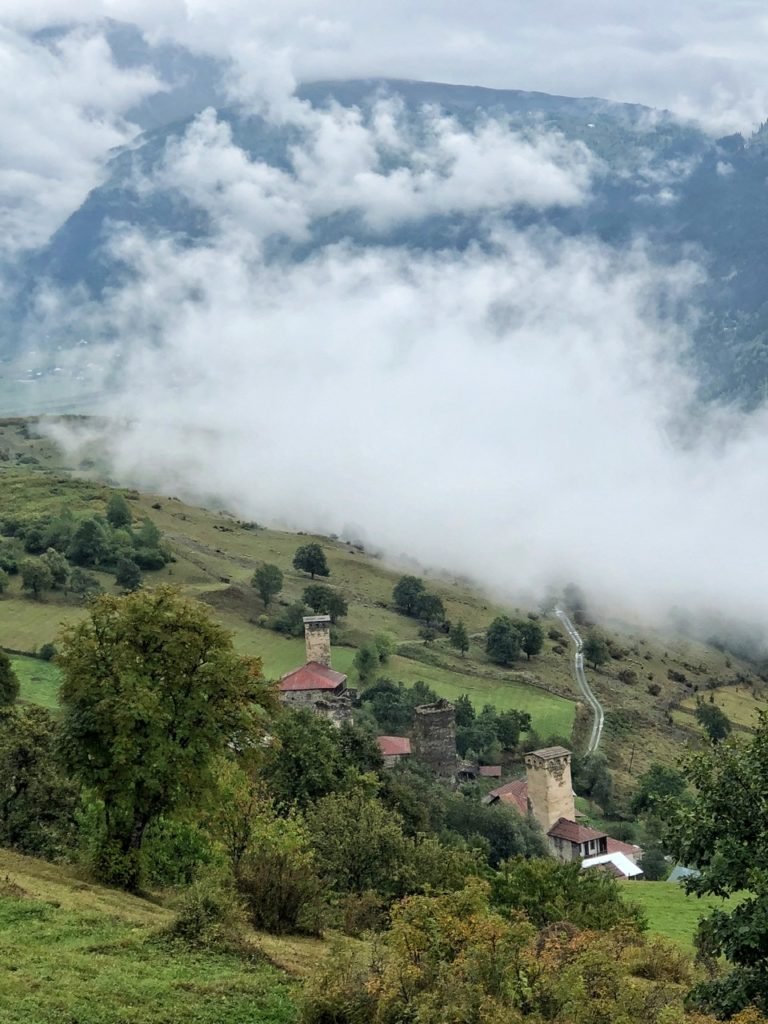
We began our 57-kilometer, 4-day trek on a drizzly Sunday morning and were on our way 16k to the village of Zhabeshi from Mestia. Needless to say, it was not the ideal way to start the trek, following trail descriptions of beautiful views and seeing nothing but fog. Fortunately the rain let up and we began to embrace the remarkable, often ruined villages we were passing on the trail.
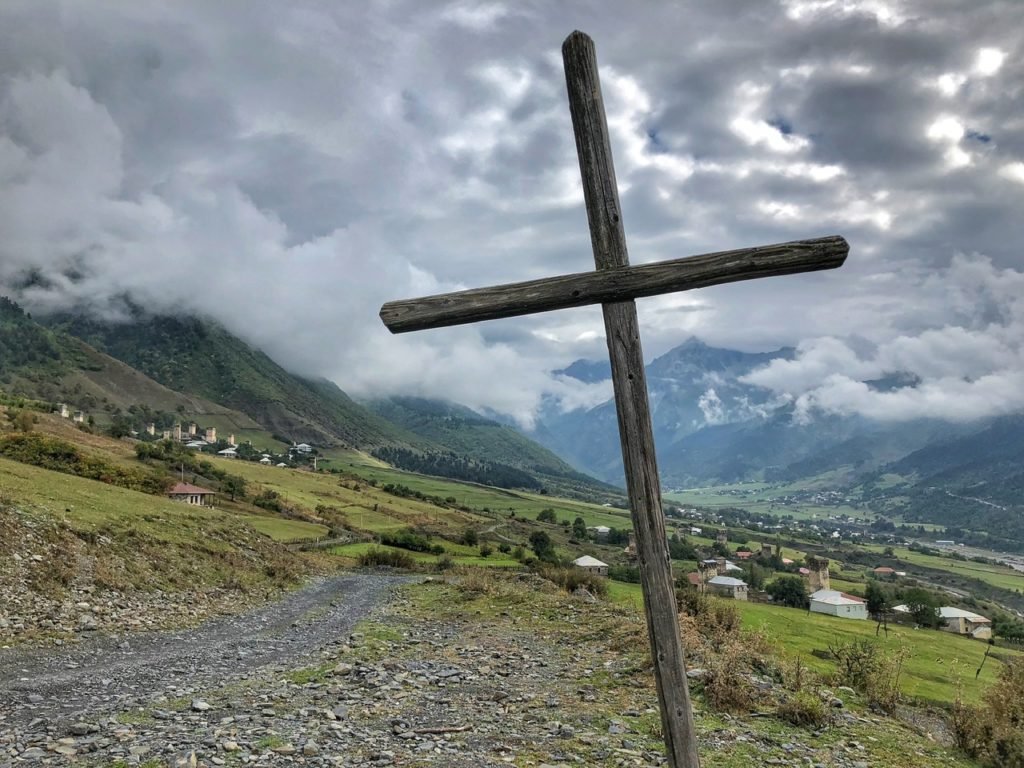
Georgia is 83% Christian so crosses and churches are plentiful.
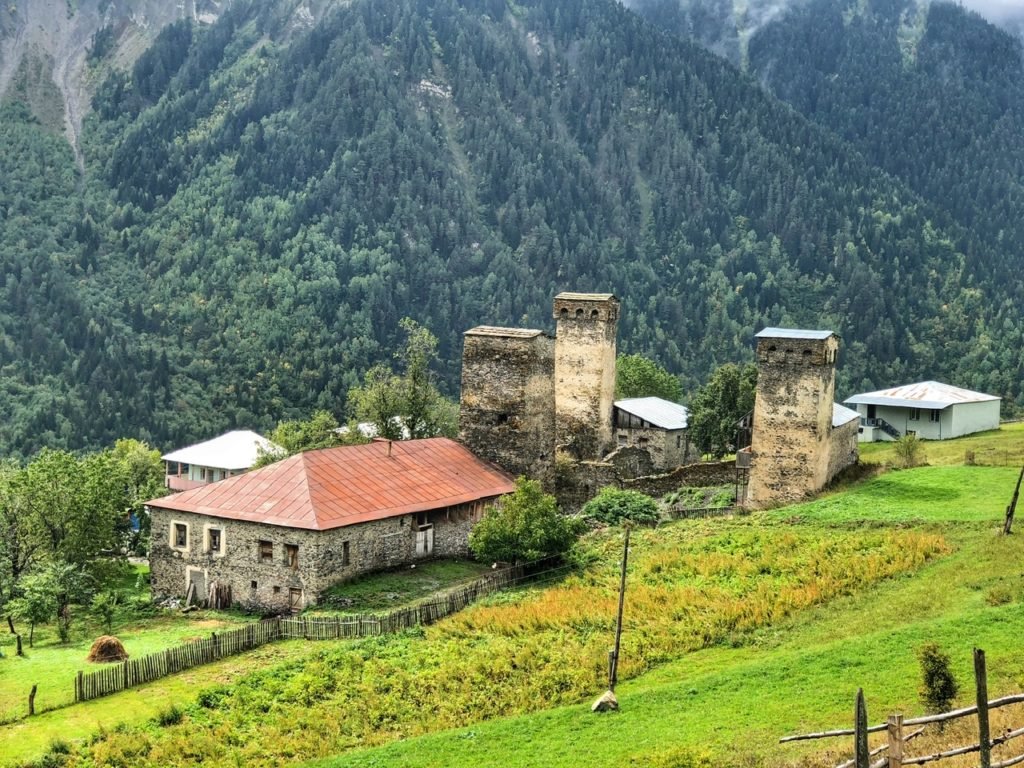
Svaneti is an ancient land, locked in the Caucasus, so remote and rugged that it was never tamed by any ruler.

Mandy stops for a photo opp. (Or to find “shelter” from the rain:)
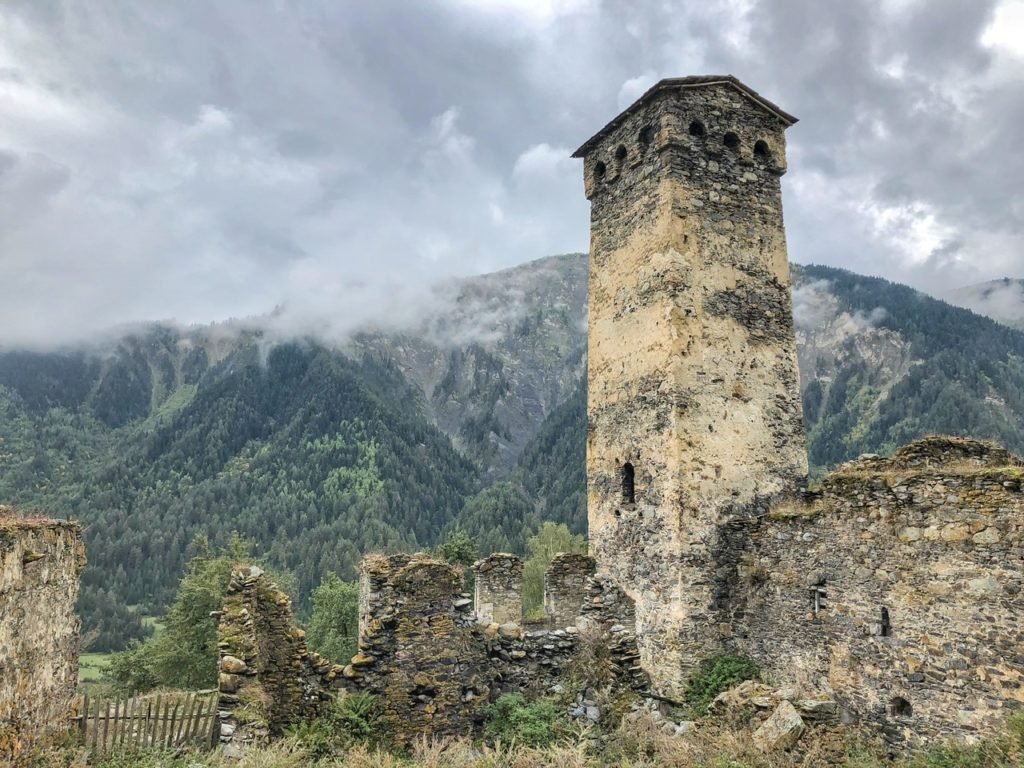
One of the villages we passed through where another Svaneti house-Tower was falling in ruins.
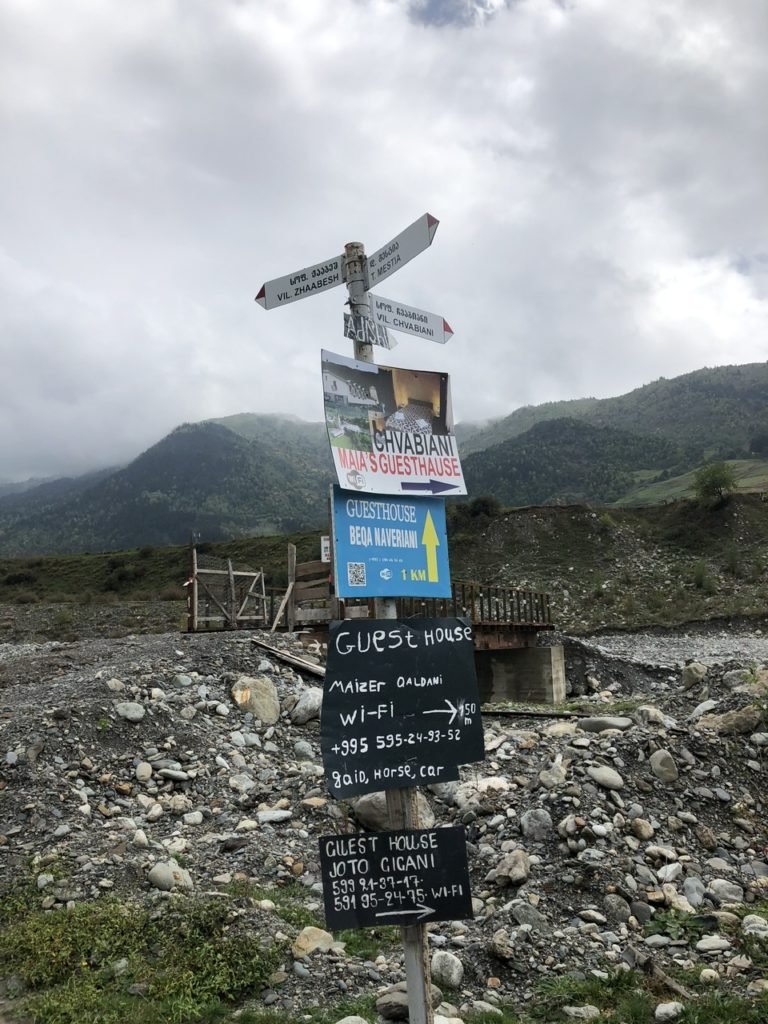
Because we were hiking village-to-village (first time, no packs, yay!) we got to choose a guesthouse each night. When you get within about a kilometer of each village, you start seeing eye catching “advertisements” for your options! I think some marketing budgets are a bit low…

One notable experience on day one was strolling down a very narrow part of the trail and coming face to face with an army of cattle. We barely had enough room to allow nearly 30 passerbys to parade by. Talk about happy cows though. We’ve never seen them roam so freely as they do in Svaneti.
And Mandy’s favorite!! The piggies!
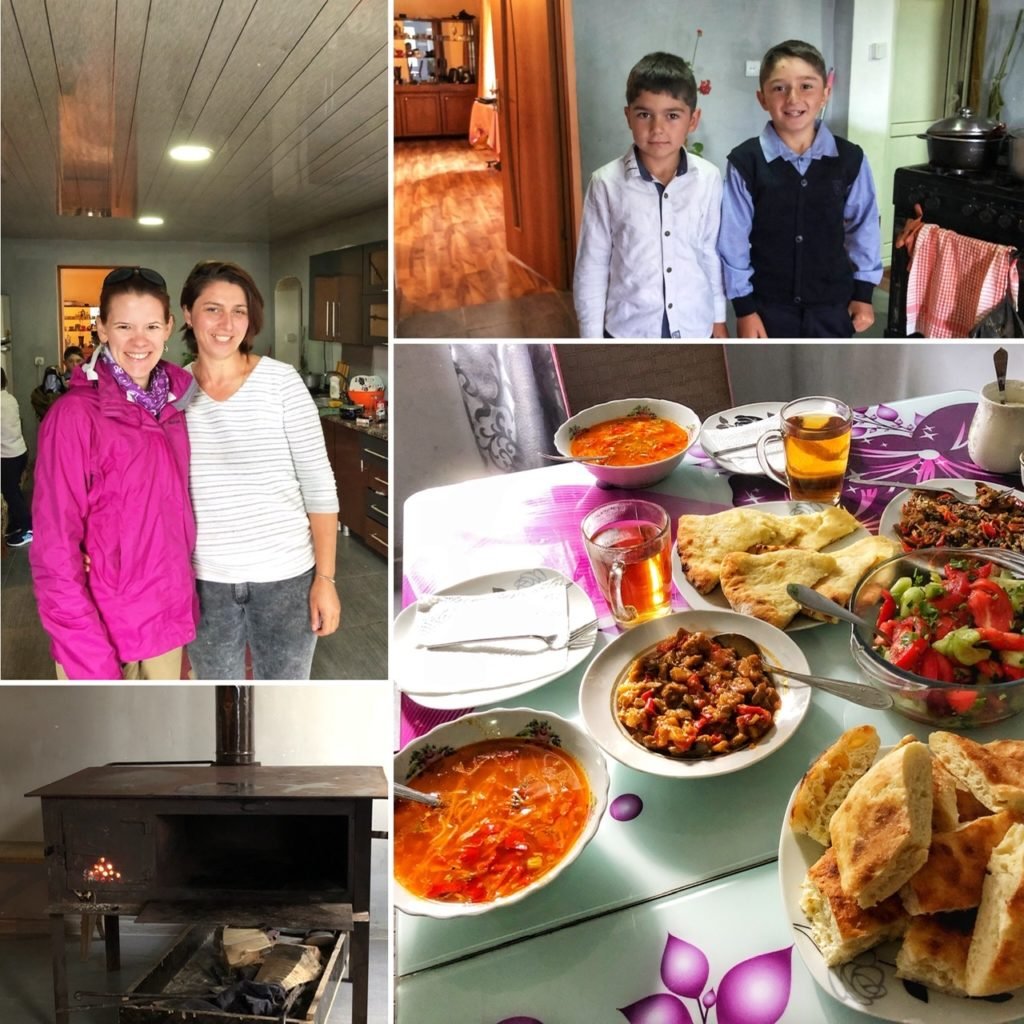
For night one, we slept at Papo’s Guesthouse in Zhabeshi. We were the only guests and Papo treated us like royalty welcoming us with a huge smile and vegetarian dinner (which was inconceivable for the two of us to finish), warm tea, and a heater (we found out later this is apparently a luxury item). The meal, as always included khachapuri, a traditional Georgian dish of cheese-filled bread, which is made in the oven pictured (in every home!), dishes of eggplant and tomatoes, and vegetable soup. Everything was outstanding and delicious… we stuffed ourselves! Although Papo’s English was minimal, she was so kind and we had basic conversation through google. Her adorable kids, on the other hand, were also excited to try out their limited, but impressive English vocabulary on us. We loved our first guesthouse experience on the trek!
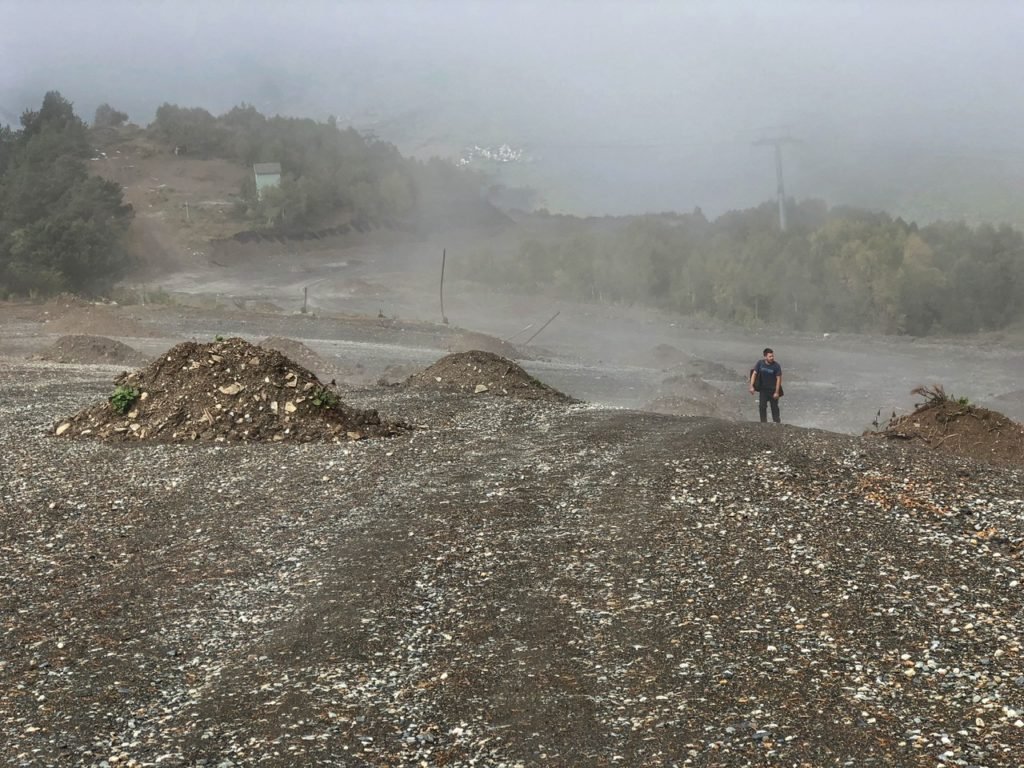
With clouds still on our side, day 2 we went 16k from Zhabeshi to Adishi villages. The first two hours was a steep incline through the forest where the leaves were already turning, which gave way to a less pleasant part of the trail which included walking on the ski resort trails. We had never been on a ski trail in summer and were interested to see how moguls are born!

The ever-present clouds started lifting slightly as the day wore on and after getting through the ski resort, we were ecstatic to run into this lovely local man who had a cabin with beers and coffee available on the side of the trail, miles from civilization! What a treat! We also treated ourselves to a “Georgian Snickers,” also known as churchkela. Walnuts on a string dipped in grape sugar syrup and dried like a sausage. Pretty tasty and perfect trail food!
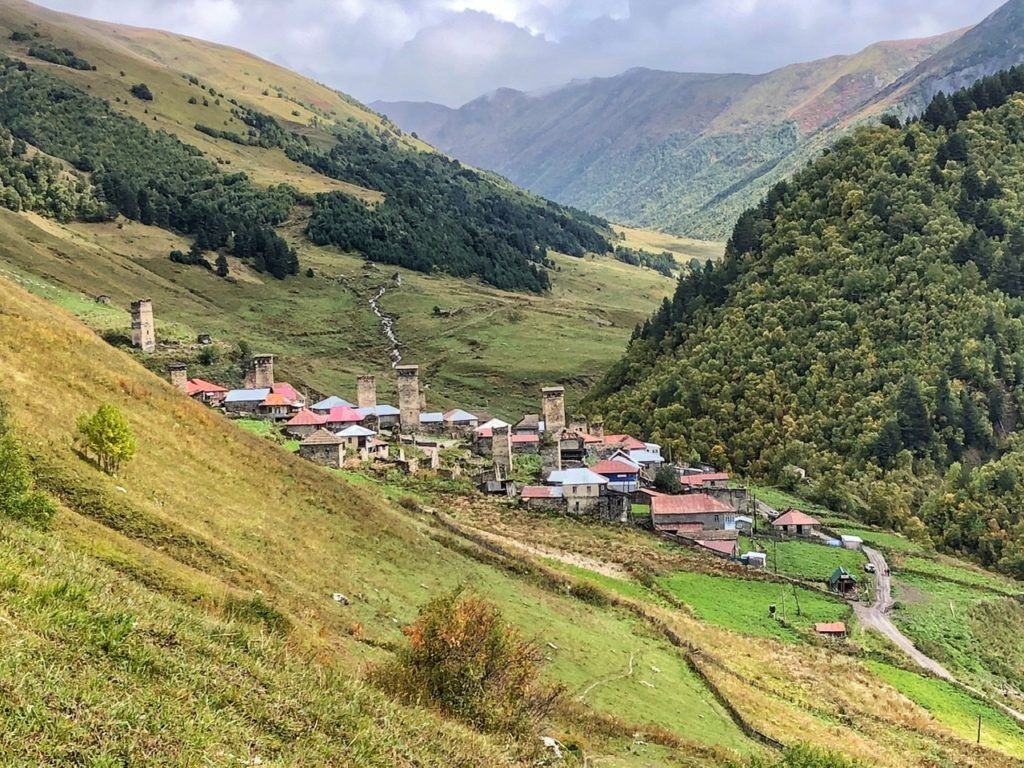
Arriving to Adishi, our highland village destination for the second night at 6700 feet. This village is mostly known for several churches from the 10th-12th centuries. Sadly, the state of the village is in great disrepair, as many of the original stone buildings have been abandoned and lie in ruin. Several Svanetian towers are crumbling like fallen soldiers, the roads are slippery mud and cow patty pits, but we were grateful the guesthouses seem to be one of the main operating “industries” obviously keeping this minuscule and precious village on the map.
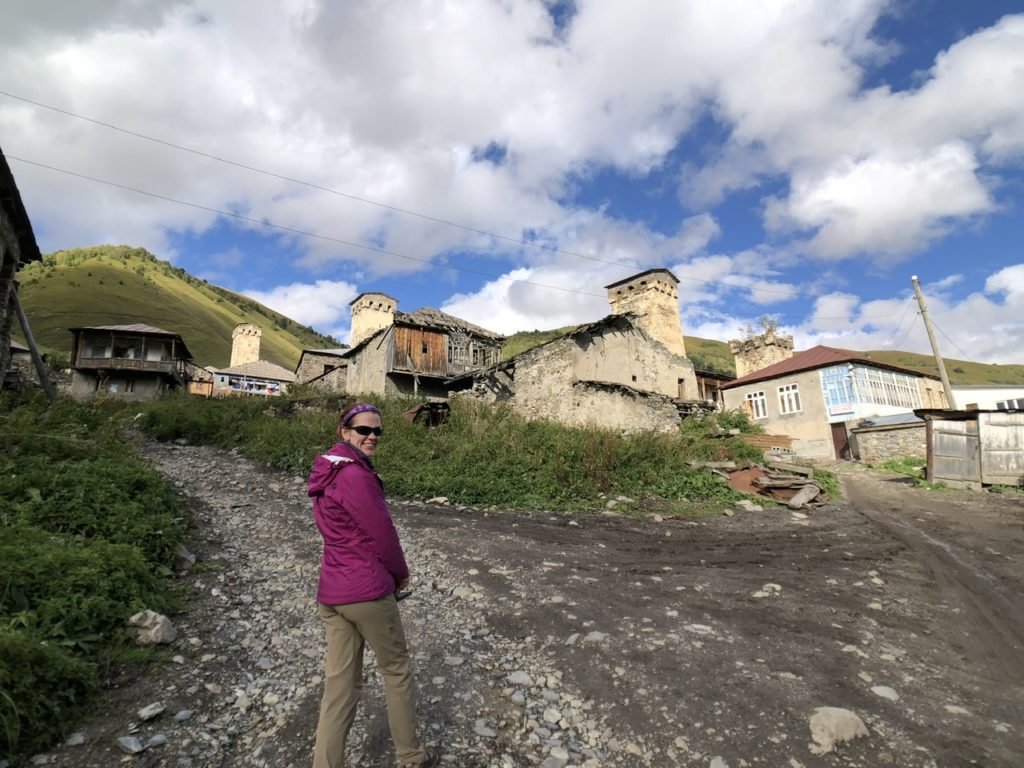
Walking the “streets” of Adishi.
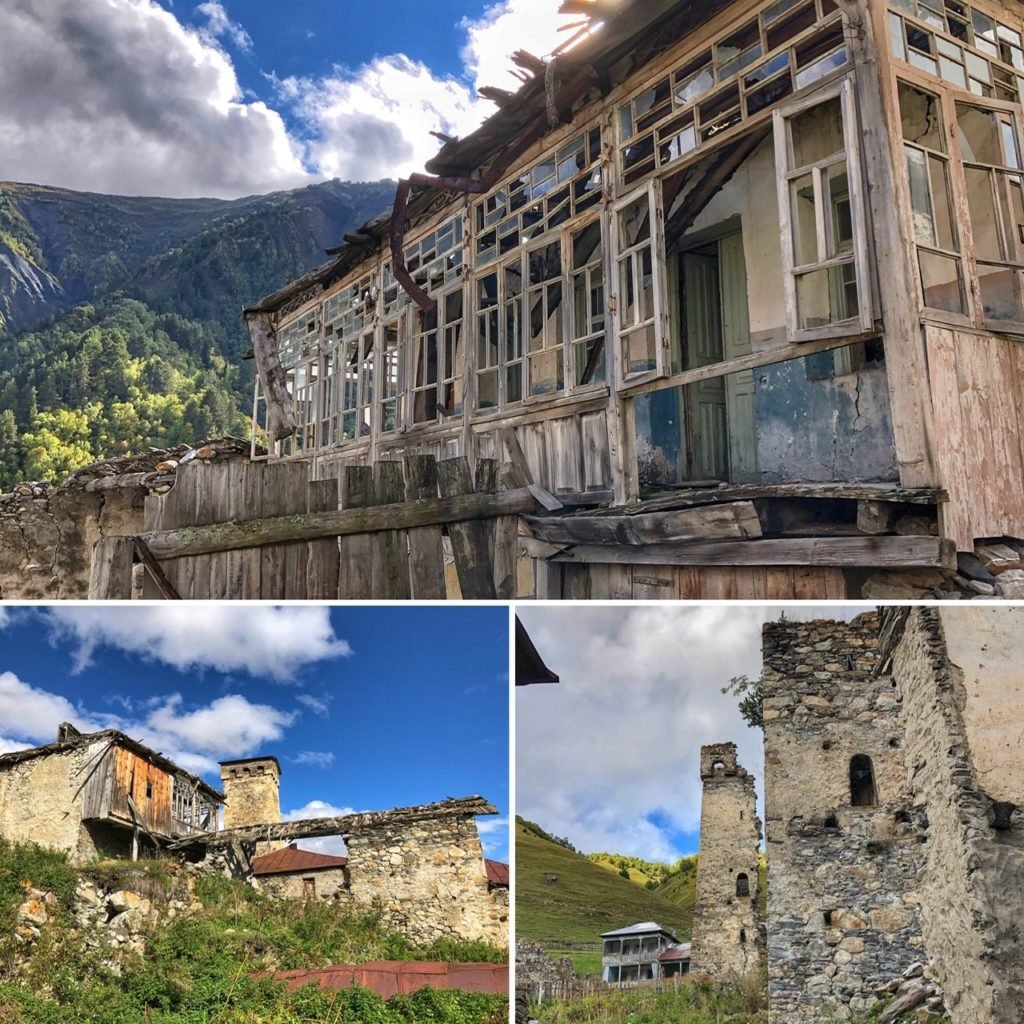
Street scenes Adishi. It was hard to look at some of these truly amazing historical treasures and structures that were once so laboriously constructed from stone and timber, now crumbling before our eyes. I think they’d be more of a Bed & Brew renovation project than we’re ready to undertake!
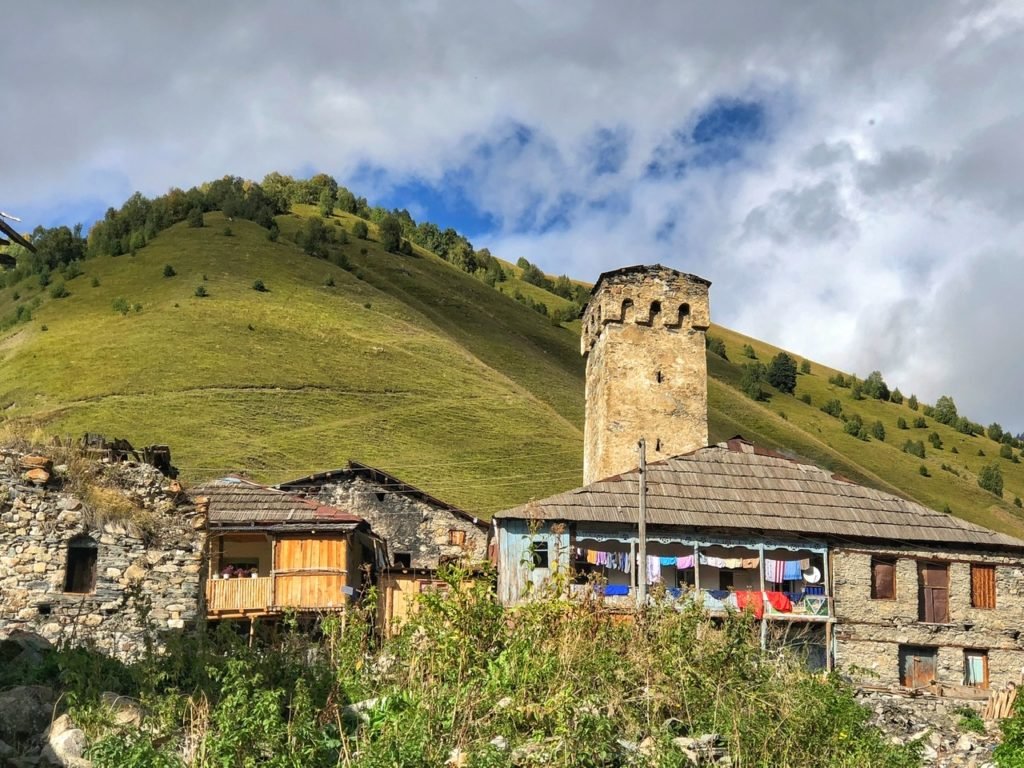
Our guesthouse home for the night in Adishi…too the right. We shared it with 6 Israelis, a frequent nationality we encountered in Georgia, and two Aussies. The company was fantastic, and so was the food. Have we mentioned Georgian food is to die for?! Our stay in the guesthouses was on average $42 for the two of us in a private room, including three meals. Downfall…no heat…and temperatures dropped to upper 30’s/lower 40’s Fahrenheit. Fortunately the blankets were very thick!
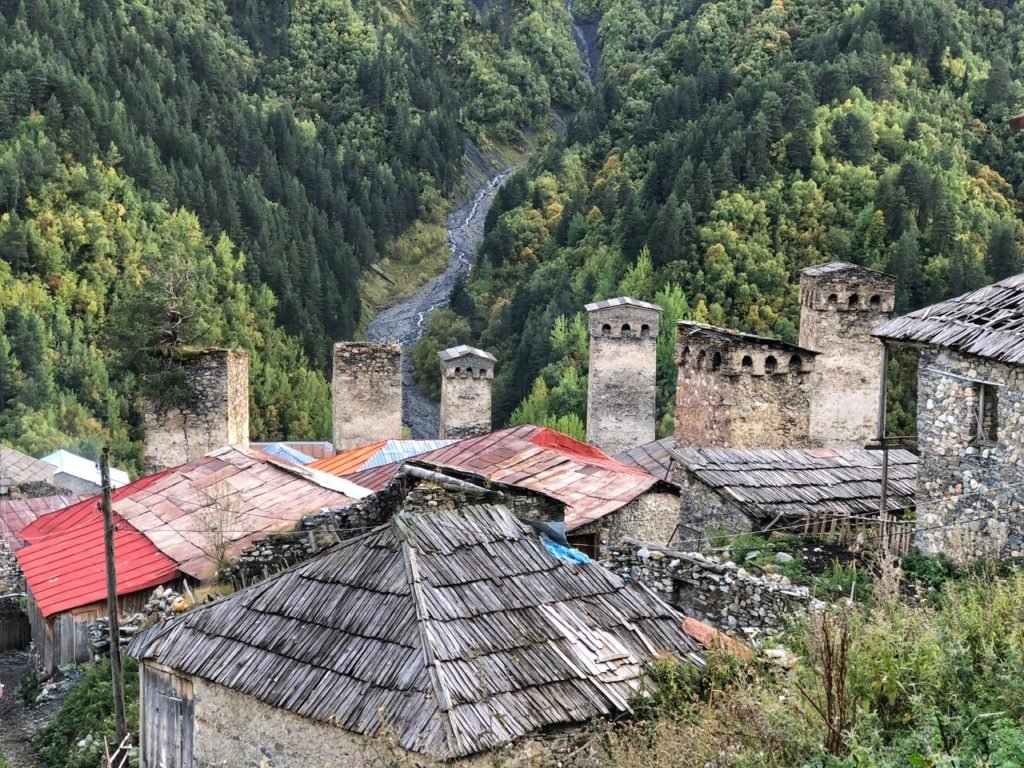
Some of the towers that dominate the Adishi “skyline.” Notice the one on the left that has a tree growing out of it!

The third day we gloriously woke to clear skies! Time to actually see the mountains we were walking amongst! For the first 7k, we walked with our guesthouse group as we had hired a guide to take us on horseback to ford the Adishi River.
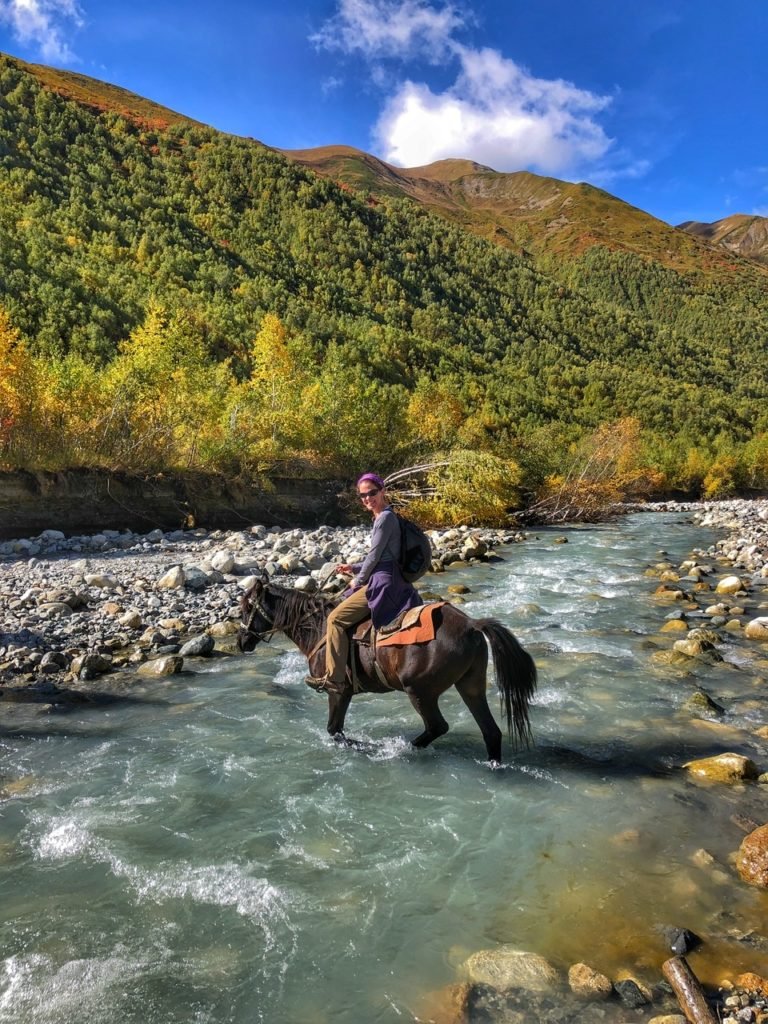
The ride was a bit of a splurge for 10 Lari—$4–for a very short distance, which we could have waded through. But at least we were giving back to the local economy, and it made for a great photo op!
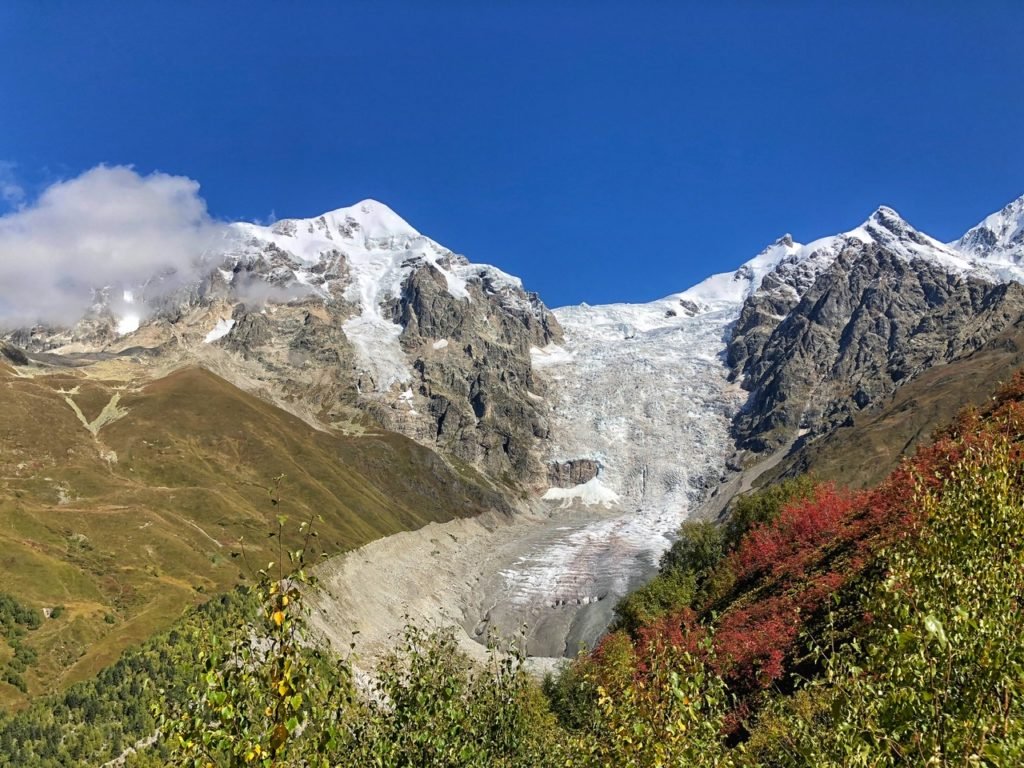
We then continued on a somewhat strenuous uphill for about 2 hours, but the views were motivating of the absolutely stunning Adishi Glacier.
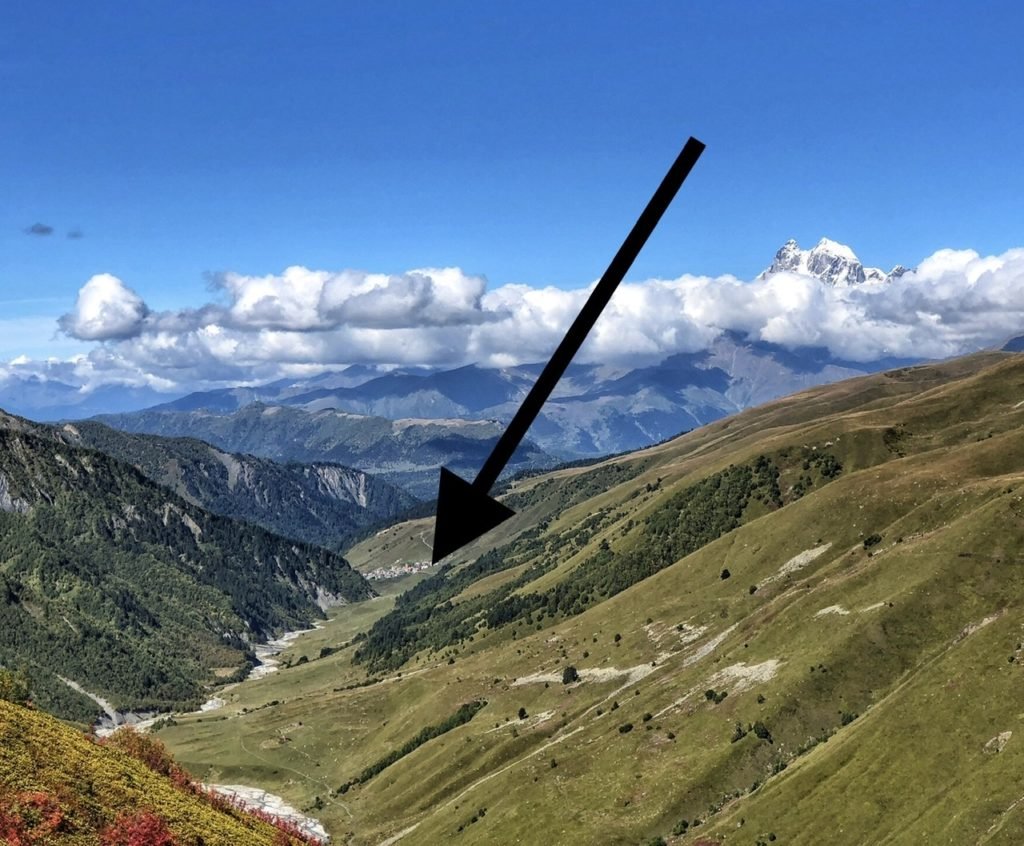
After a long uphill, the view was simply magnificent as we looked back down the Adishi valley. The arrow is Adishi Village where we had started about 11k earlier. In the background is Mt Ushba, another spectacular Caucus Mountain Peak.
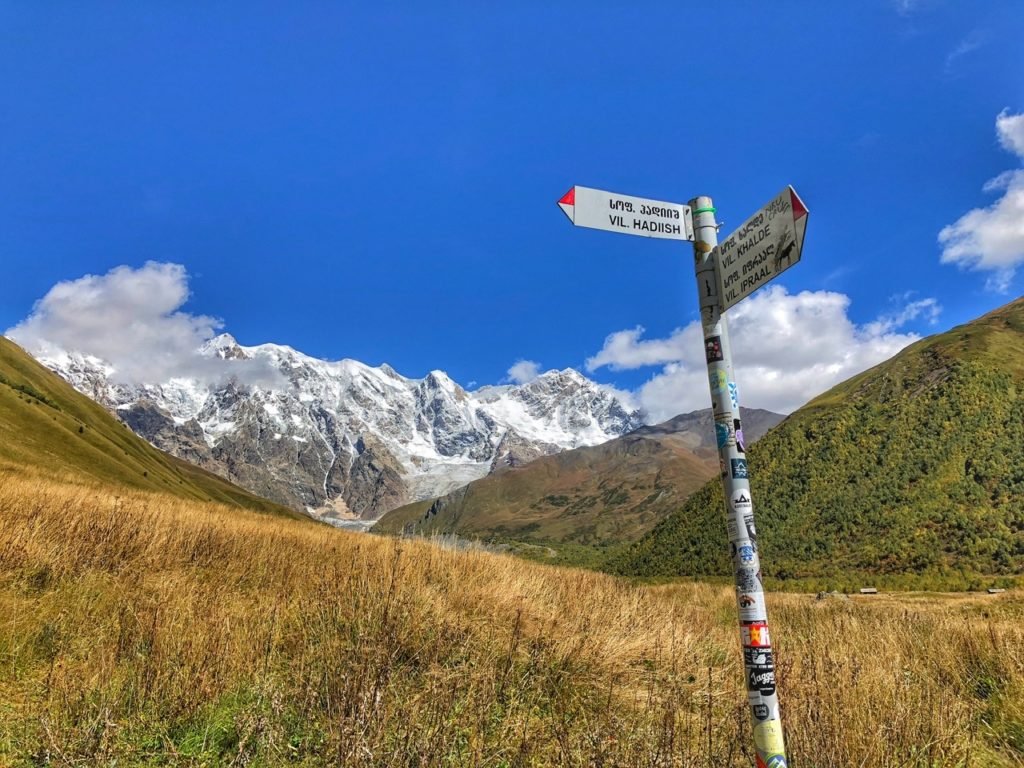
The views continued throughout the day. A stop at a trail maker.
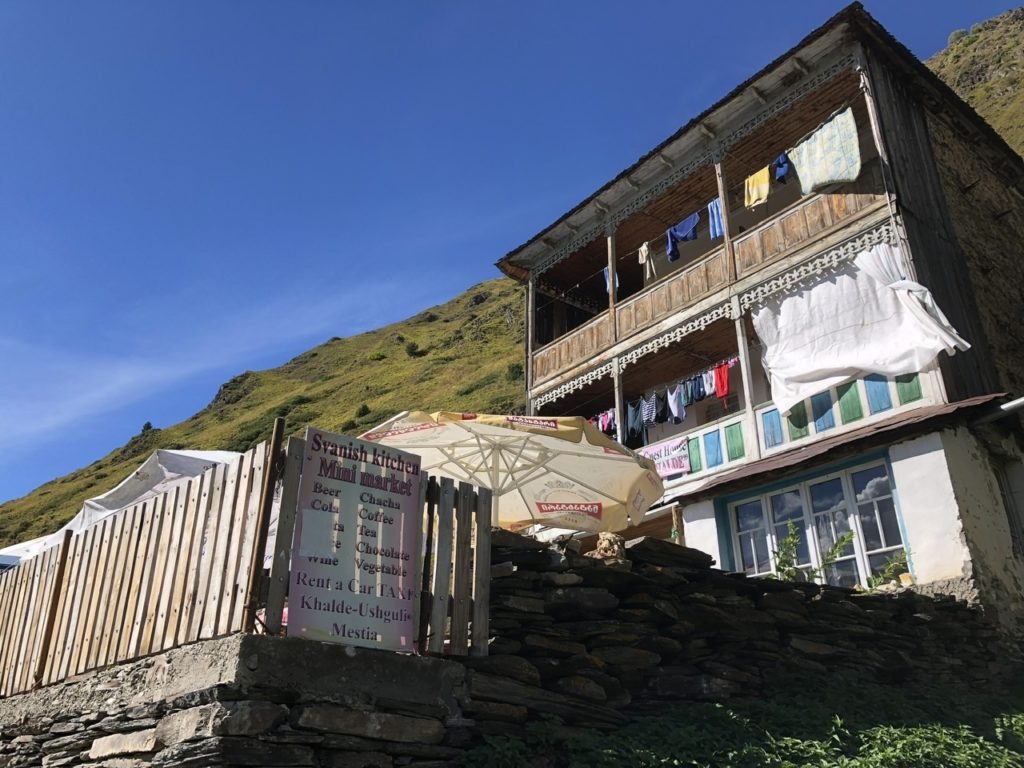
Stopping for a beer in the Khalde village. We thought this guesthouse was a little reminiscent of what you might find in the Himalayas.
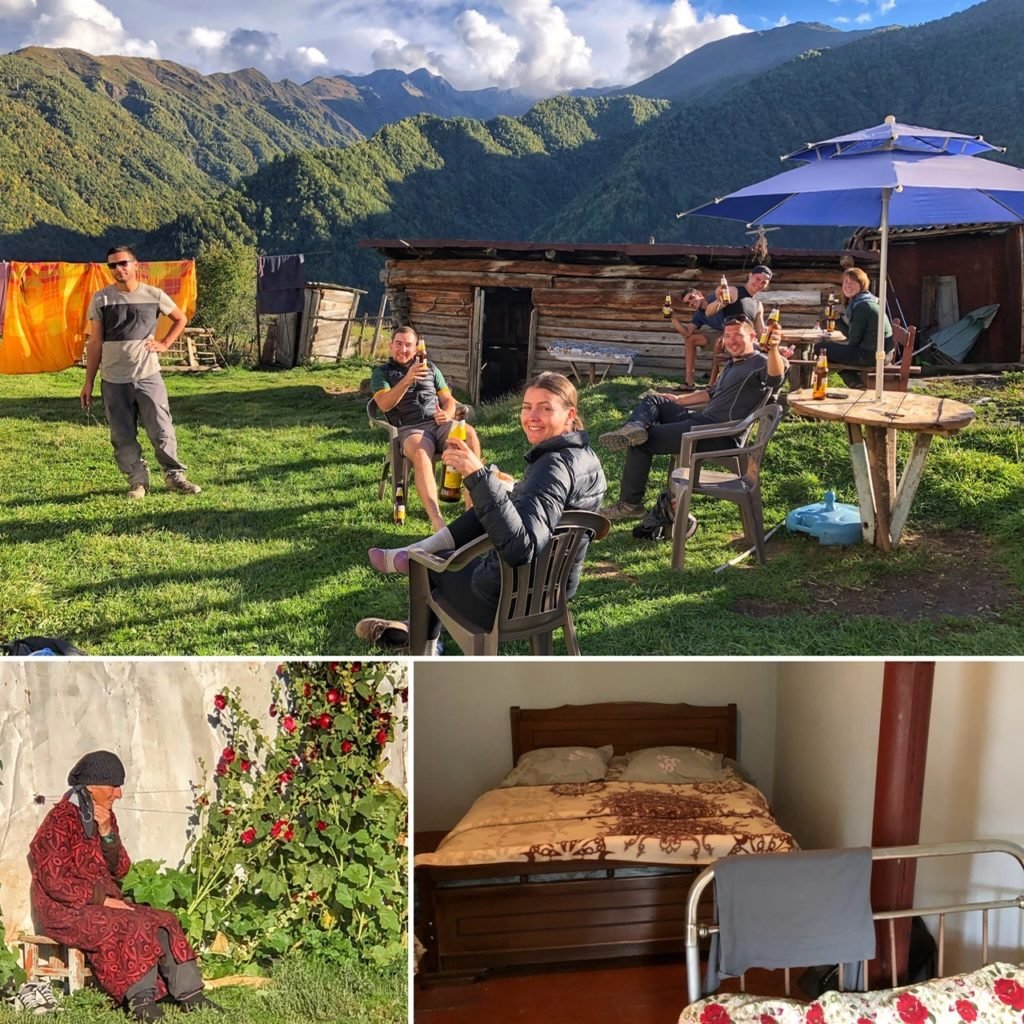
After our longest, but also most rewarding day of 20k, we arrived in Ipnari Village, which only had three guesthouse options. Fortunately we snagged one, and the company (and not so much the food) truly made this one special. We all enjoyed beers in the backyard upon arrival and stayed up playing “celebrity” (apparently its global!) with more Israelis, a Brit and a Scot who were bicycling across Europe/Asia, 2 Germans, and the already familiar friends from Down Under. Also pictured is the adorable grandma who lived there, and a typical guesthouse room.
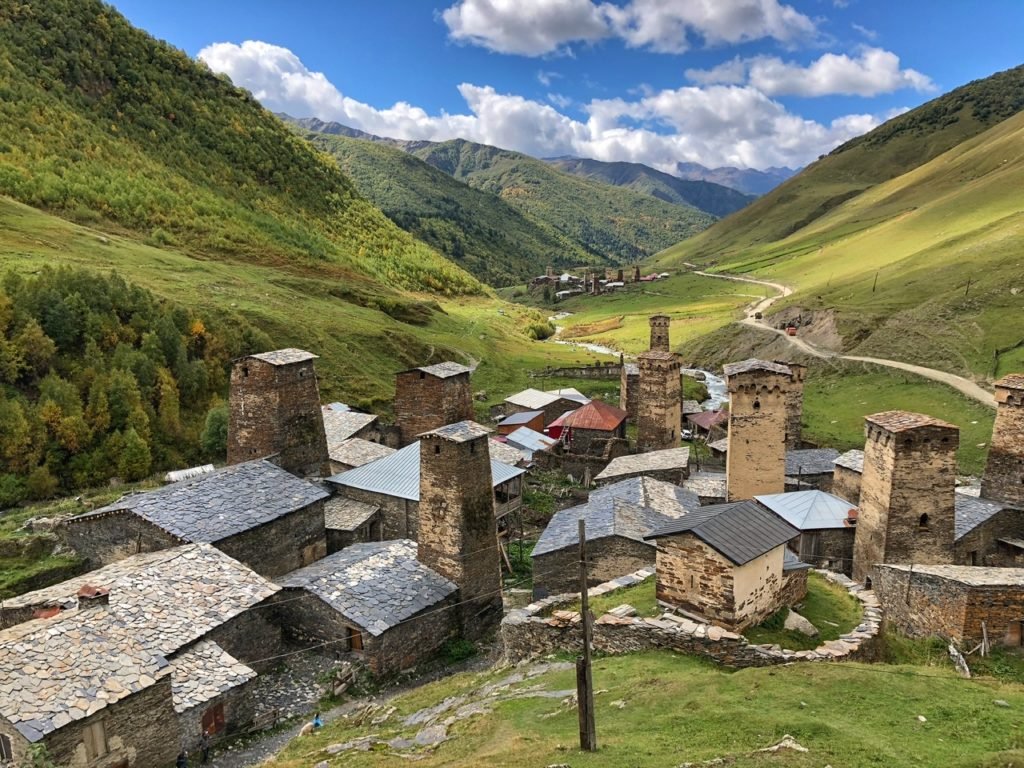
Day 4 started equally as beautiful as the third and we walked our easiest day of 15k. Arriving to our final destination of Ushguli was everything we had dreamed. It is well-worth staying the extra overnight before heading back to Mestia. Ushguli consists of five villages within its community, one of which (Chazhashi) has been preserved by UNESCO since 1996. It has preserved more than 200 medieval tower houses, buildings, churches and castles. According to UNESCO.org, the origins of Svaneti tower houses go back to prehistory. Its features reflect the traditional economic mode and social organization of Svan communities. These towers usually have three to five floors, and the thickness of the walls decreases, giving the towers a slender, tapering profile. The houses themselves are usually two-storeyed; the ground floor is a single hall with an open hearth and accommodation for both people and domestic animals, the latter being separated by a wooden partition, which is often lavishly decorated. A corridor annex helped the thermal insulation of the building. The upper floor was used by the human occupants during summer, and also served as a store for fodder and tools. A door at this level provided access to the tower, which was also connected with the corridor that protected the entrance. The houses were used both as dwellings and as defence posts against the invaders who plagued the region.
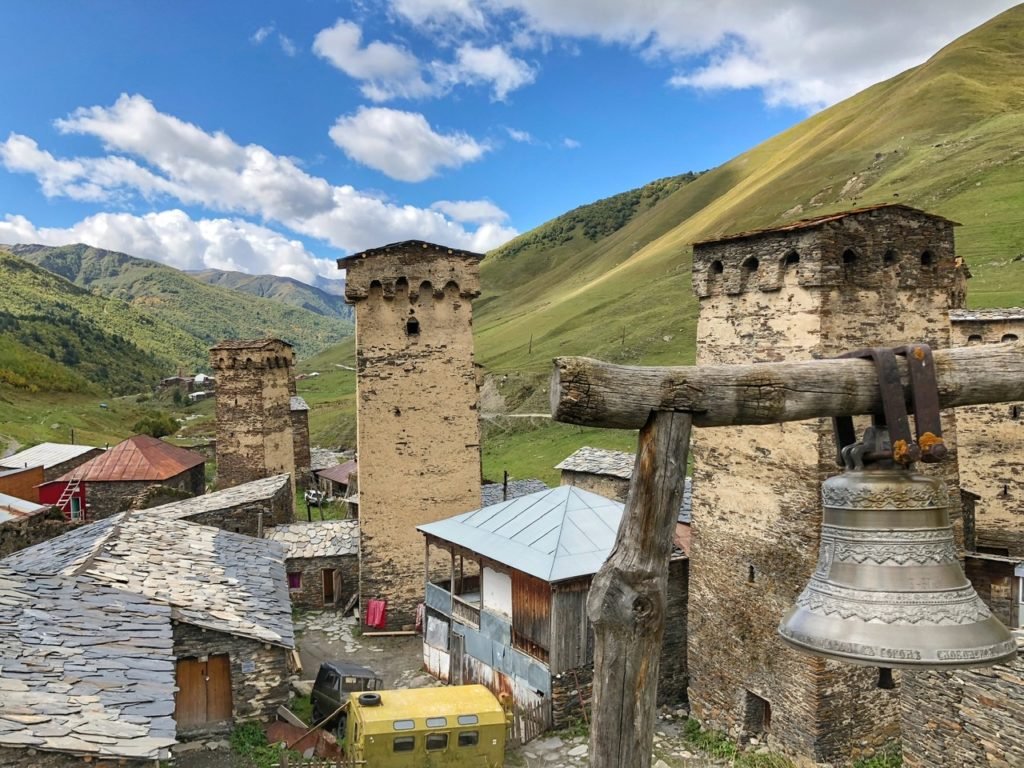
Another gorgeous view of the village.

The mountain which dominates the village, Shkhara, is the biggest in Georgia and the third biggest in the Caucuses at 17,060 feet. It also serves as the border between Georgia and Russia and was a idyllic place for Mandy to meditate early in the morning.
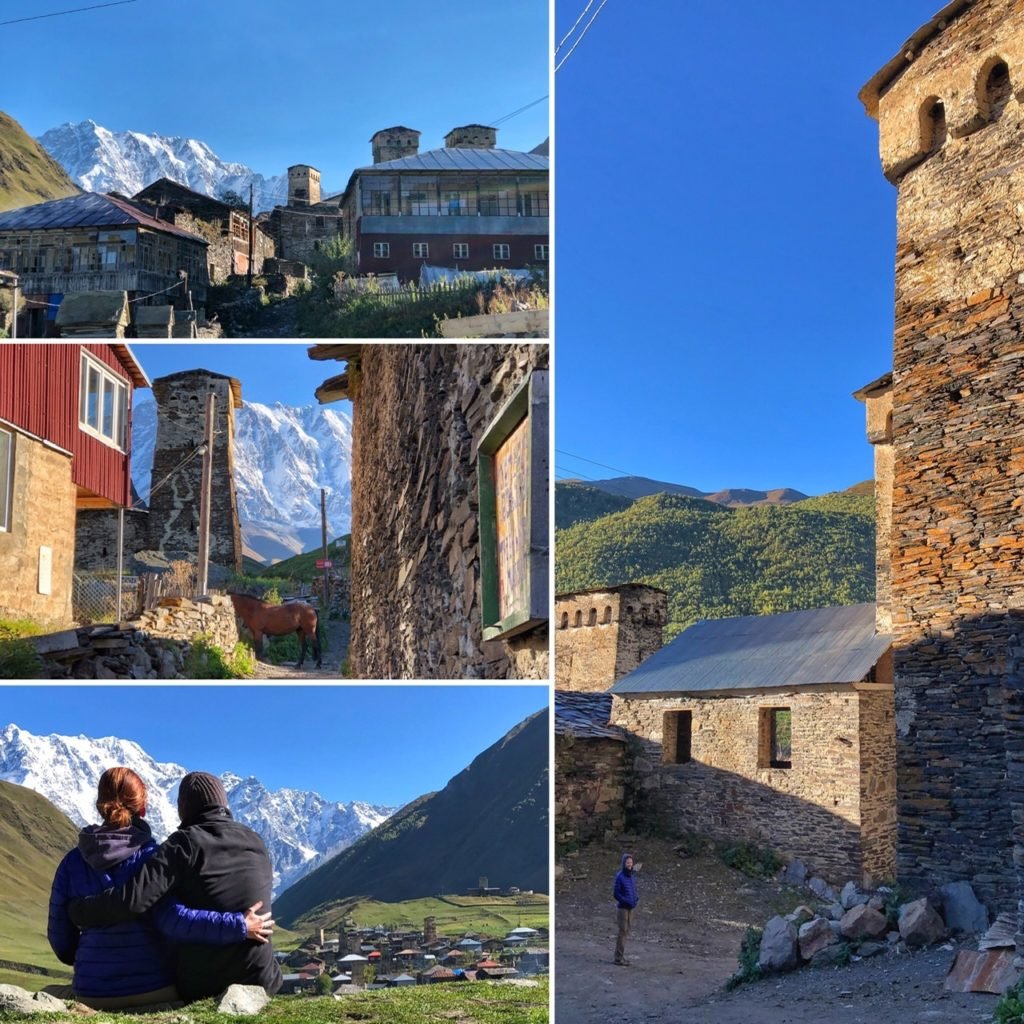
Exploring the precious village of Ushguli. Simply awesome, and a perfect end cap to our time in Svaneti. Truly an epic journey.


